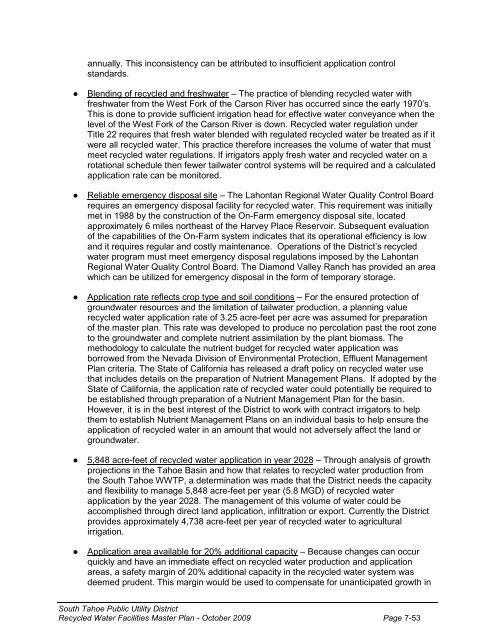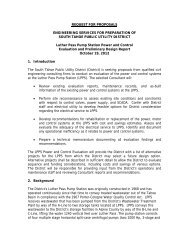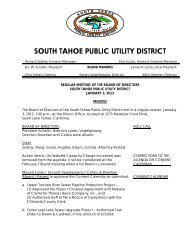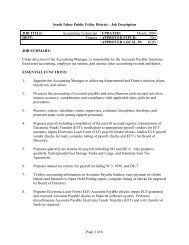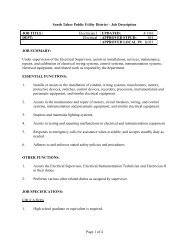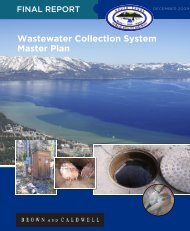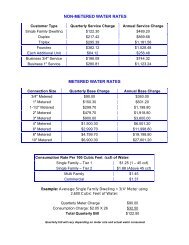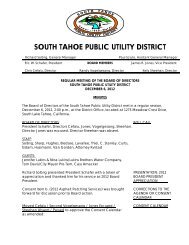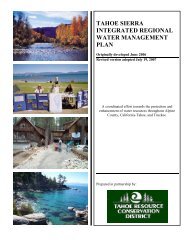October 2009 - South Tahoe Public Utility District
October 2009 - South Tahoe Public Utility District
October 2009 - South Tahoe Public Utility District
You also want an ePaper? Increase the reach of your titles
YUMPU automatically turns print PDFs into web optimized ePapers that Google loves.
annually. This inconsistency can be attributed to insufficient application control<br />
standards.<br />
●<br />
●<br />
●<br />
●<br />
●<br />
Blending of recycled and freshwater – The practice of blending recycled water with<br />
freshwater from the West Fork of the Carson River has occurred since the early 1970‟s.<br />
This is done to provide sufficient irrigation head for effective water conveyance when the<br />
level of the West Fork of the Carson River is down. Recycled water regulation under<br />
Title 22 requires that fresh water blended with regulated recycled water be treated as if it<br />
were all recycled water. This practice therefore increases the volume of water that must<br />
meet recycled water regulations. If irrigators apply fresh water and recycled water on a<br />
rotational schedule then fewer tailwater control systems will be required and a calculated<br />
application rate can be monitored.<br />
Reliable emergency disposal site – The Lahontan Regional Water Quality Control Board<br />
requires an emergency disposal facility for recycled water. This requirement was initially<br />
met in 1988 by the construction of the On-Farm emergency disposal site, located<br />
approximately 6 miles northeast of the Harvey Place Reservoir. Subsequent evaluation<br />
of the capabilities of the On-Farm system indicates that its operational efficiency is low<br />
and it requires regular and costly maintenance. Operations of the <strong>District</strong>‟s recycled<br />
water program must meet emergency disposal regulations imposed by the Lahontan<br />
Regional Water Quality Control Board. The Diamond Valley Ranch has provided an area<br />
which can be utilized for emergency disposal in the form of temporary storage.<br />
Application rate reflects crop type and soil conditions – For the ensured protection of<br />
groundwater resources and the limitation of tailwater production, a planning value<br />
recycled water application rate of 3.25 acre-feet per acre was assumed for preparation<br />
of the master plan. This rate was developed to produce no percolation past the root zone<br />
to the groundwater and complete nutrient assimilation by the plant biomass. The<br />
methodology to calculate the nutrient budget for recycled water application was<br />
borrowed from the Nevada Division of Environmental Protection, Effluent Management<br />
Plan criteria. The State of California has released a draft policy on recycled water use<br />
that includes details on the preparation of Nutrient Management Plans. If adopted by the<br />
State of California, the application rate of recycled water could potentially be required to<br />
be established through preparation of a Nutrient Management Plan for the basin.<br />
However, it is in the best interest of the <strong>District</strong> to work with contract irrigators to help<br />
them to establish Nutrient Management Plans on an individual basis to help ensure the<br />
application of recycled water in an amount that would not adversely affect the land or<br />
groundwater.<br />
5,848 acre-feet of recycled water application in year 2028 – Through analysis of growth<br />
projections in the <strong>Tahoe</strong> Basin and how that relates to recycled water production from<br />
the <strong>South</strong> <strong>Tahoe</strong> WWTP, a determination was made that the <strong>District</strong> needs the capacity<br />
and flexibility to manage 5,848 acre-feet per year (5.8 MGD) of recycled water<br />
application by the year 2028. The management of this volume of water could be<br />
accomplished through direct land application, infiltration or export. Currently the <strong>District</strong><br />
provides approximately 4,738 acre-feet per year of recycled water to agricultural<br />
irrigation.<br />
Application area available for 20% additional capacity – Because changes can occur<br />
quickly and have an immediate effect on recycled water production and application<br />
areas, a safety margin of 20% additional capacity in the recycled water system was<br />
deemed prudent. This margin would be used to compensate for unanticipated growth in<br />
<strong>South</strong> <strong>Tahoe</strong> <strong>Public</strong> <strong>Utility</strong> <strong>District</strong><br />
Recycled Water Facilities Master Plan - <strong>October</strong> <strong>2009</strong> Page 7-53


